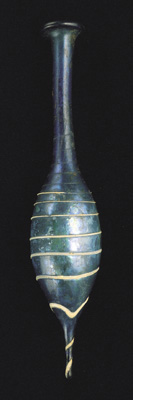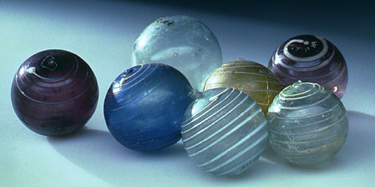Elegant Simplicity


Amphora-shaped unguentarium
Ht., 16.6 cm
Mid 1st century A.D.
Inv. MS 5005
"When sleep deserts your gentle limbs, arise
And learn the way to dazzle all men's eyes....
Whoever puts this lotion on her face
Will make her mirror take a second place."
(Ovid, On Facial Cosmetics.51)
Once glassblowing became commonplace in Italy during the Augustan era, most Roman cosmetic bottles (unguentaria) were mass produced. This one does, however, stand out in the crowd, because of its delicacy of shape and color. Its white spiral decoration was one of the most fashionable decorative motifs for smaller items of glassware during the mid 1st century A.D.
Small glass spheres were sometimes used to store perfumed oils, the contents being kept fresh by melting shut the filling hole at the top. It is easy to imagine how the elegant form of our unguentarium was created simply by stretching out one of these spheres, at both the top and the bottom.
REFERENCES
- Fleming, S.J., 1996: Early Imperial Roman Glass at the University of Pennsylvania Museum,” Expedition 38.3, 13-37.
- Fleming, S.J., 1999: Roman Glass: Reflections on Cultural Change, 31-35 (Philadelphia: University of Pennsylvania Museum).
- Grose, D.F., 1977: “Early Blown Glass,” Journal of Glass Studies 19, 9-29.
- Israeli, Y., 1991: “The Invention of Blowing,” Roman Glass: Two Centuries of Art and Invention, 46-55 (edits., M. Newby and K. Painter;
- London: Society of Antiquaries of London).Price, J., 1977: Roman Unguent Bottles from Rio Tinto (Hulelva) in Spain,” Journal of Glass Studies 19, 30-49.

Sphere unguentaria, variously colored and decorated
From Hermesdorf, in Germany
